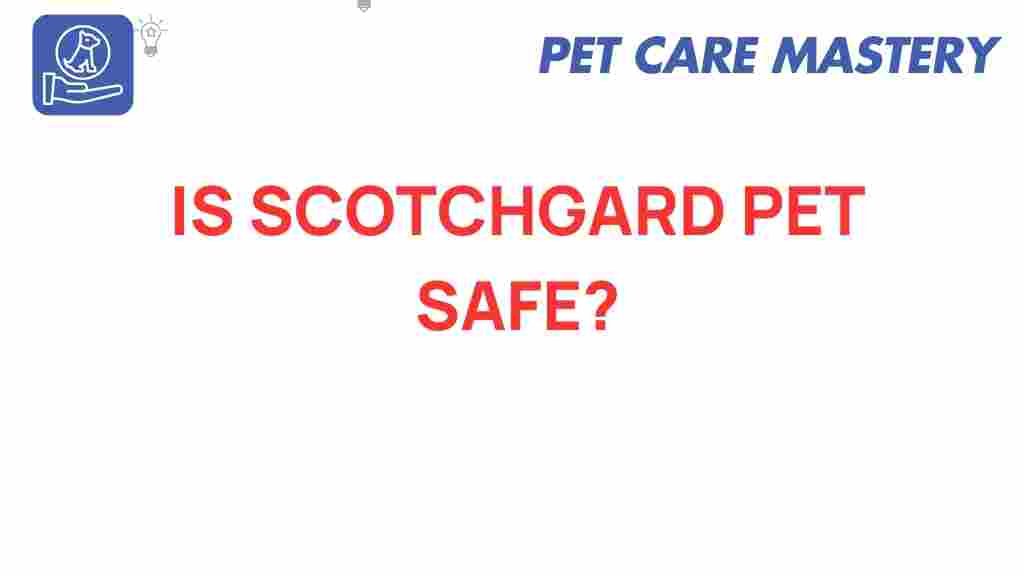Is Scotchgard Pet Safe? Unraveling the Truth Behind the Myth
When it comes to protecting furniture and carpets, many homeowners turn to Scotchgard, a popular fabric protector known for its ability to repel stains and spills. However, pet owners often find themselves asking: Is Scotchgard pet safe? This question is particularly important for those who share their homes with furry friends. In this article, we will explore the safety of Scotchgard for pets, dispel common myths, and provide guidance on how to use it responsibly.
Understanding Scotchgard: What Is It?
Scotchgard is a brand of water-repellent and stain-resistant treatment that can be applied to various surfaces, including upholstery, carpets, and outdoor fabrics. The product works by creating a protective barrier that prevents liquids from penetrating the fibers, making it easier to clean spills and maintain the appearance of fabrics. While Scotchgard has been a trusted name in fabric protection for years, concerns about its safety for pets have led to increased scrutiny.
Is Scotchgard Safe for Pets? The Science Behind It
To determine whether Scotchgard is safe for pets, we need to look at the ingredients and how the product functions. Scotchgard contains fluoropolymers, which are compounds that provide water and stain resistance. Historically, some fluorinated compounds have been linked to health concerns, but recent formulations of Scotchgard are generally considered safe when used according to the manufacturer’s instructions.
In 2017, 3M, the company that produces Scotchgard, reformulated the product to eliminate certain harmful chemicals, making it safer for both humans and pets. However, it is always wise to take precautions when applying any chemical product in your home.
How to Safely Use Scotchgard Around Pets
If you decide to use Scotchgard in your home, following these steps can help ensure the safety of your pets:
- Choose the Right Product: Always opt for the latest formula of Scotchgard that is labeled as pet-safe.
- Ventilate the Area: When applying Scotchgard, make sure the room is well-ventilated to minimize any chemical fumes. Open windows and use fans if necessary.
- Keep Pets Away: Before application, remove pets from the area. Keep them away until the treatment has completely dried—this usually takes a few hours.
- Read the Instructions: Always follow the manufacturer’s instructions for application and drying times.
Common Myths About Scotchgard and Pets
As with many popular products, myths about Scotchgard and its safety for pets abound. Here are a few common misconceptions:
- Myth 1: Scotchgard is toxic to pets.
- Myth 2: Pets can’t be around Scotchgard-treated surfaces at all.
- Myth 3: All fabric protectors are the same as Scotchgard.
While it is true that some older formulations of fabric protectors may have contained harmful chemicals, the modern Scotchgard is designed to be safer. Always check the label for specific pet safety information.
Step-by-Step Guide to Applying Scotchgard
If you’ve decided to use Scotchgard for your furniture or carpets, follow this step-by-step guide for proper application:
- Clean the Surface: Before applying Scotchgard, ensure the surface is clean and dry. Vacuum upholstery and carpets to remove any debris.
- Test a Small Area: Before full application, test Scotchgard on a small, inconspicuous area to ensure it does not alter the color or texture.
- Apply Evenly: Hold the canister about 6-8 inches away from the surface and spray in a sweeping motion. Apply a thin, even coat without saturating the fabric.
- Allow to Dry: Let the Scotchgard dry completely, which usually takes at least 2 hours. Make sure pets are kept away during this time.
- Apply Additional Coats: For maximum protection, consider applying a second coat after the first has dried.
Troubleshooting Tips for Scotchgard Application
While applying Scotchgard, you may encounter some issues. Here are a few troubleshooting tips:
- Sticky Residue: If you experience sticky residue after applying Scotchgard, it may be due to over-saturation. Make sure to apply thin, even coats in the future.
- Color Change: If you notice a color change after application, discontinue use on that fabric and consult a professional cleaner.
- Foul Odor: If there is an unpleasant smell after application, ensure the area is well-ventilated to help dissipate the odor.
Alternative Pet-Safe Fabric Protectors
If you’re still concerned about using Scotchgard, there are alternative fabric protectors that are marketed as pet-safe. Here are a few options:
- Natural Protectors: Some products use natural ingredients, such as plant-based oils, to create a protective barrier without harsh chemicals.
- DIY Solutions: You can create your own fabric protector using a mixture of water and white vinegar or other household items that repel stains.
- Consult Professionals: If you’re unsure, consider hiring a professional cleaning service that specializes in pet-safe products.
Conclusion: Making Informed Choices About Scotchgard
In conclusion, Scotchgard can be a safe option for pet owners when used correctly. By choosing the latest formulation, following application instructions, and taking appropriate precautions, you can protect your furniture and carpets without compromising the safety of your pets.
However, if you have any doubts or concerns, there are alternative products available that may suit your needs better. Always prioritize the health and safety of your pets in your decision-making process.
For more information on pet safety and household products, check out this helpful resource. Additionally, if you’re looking for more tips on maintaining a pet-friendly home, feel free to explore our other articles here.
This article is in the category Products and created by PetCareMastery Team
